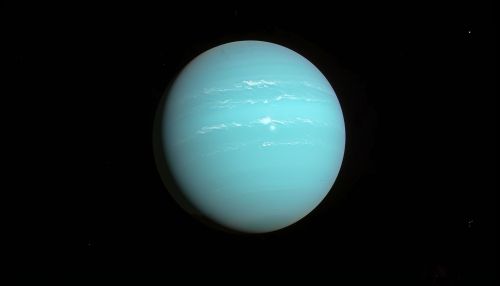Uranus
Overview
Uranus is the seventh planet from the Sun and the third-largest and fourth-most massive planet in the Solar System. Named after the ancient Greek deity of the sky Uranus, the father of Cronus (Saturn) and grandfather of Zeus (Jupiter), it is the only planet whose name is derived directly from a figure of Greek mythology.
Discovery and naming
Uranus was officially discovered by Sir William Herschel in 1781. It was a significant discovery because it expanded the known boundaries of the Solar System. Herschel originally wanted to name the planet 'Georgium Sidus' (George's Star), after King George III of England. However, the international astronomy community didn't think that was a suitable name. Instead, they chose to continue the trend of naming planets after ancient Roman deities. Uranus was named after the Greek god of the sky, Ouranos.


Physical characteristics
Uranus is known for its distinctive blue-green color, which is the result of methane in its atmosphere absorbing red light. The planet is often referred to as an "ice giant" because it possesses a mantle of water, ammonia, and methane ices that overlay an Earth-sized core of rock and metal. Uranus's atmosphere is composed primarily of hydrogen and helium, with a small amount of methane and traces of water and ammonia.
Internal structure
The internal structure of Uranus is different from the structure of the four terrestrial planets; it is also slightly different from that of Jupiter and Saturn. It has a core of rock and metal, surrounded by a mantle of icy materials. Above that is an outer envelope of molecular hydrogen, helium, and a small amount of methane.
Atmosphere
The atmosphere of Uranus is composed primarily of hydrogen and helium, with a small amount of methane. The presence of methane is part of what gives Uranus its blue color. In addition to these primary components, the atmosphere contains trace amounts of water vapor, ammonia, and hydrocarbons.
Magnetosphere
Uranus has a complex magnetic environment, with a magnetic field that is both large and unusual. The magnetic field is tilted at 59 degrees from the planet's axis of rotation, which itself is tilted at an angle of 98 degrees to the plane of Uranus's orbit around the Sun. This unique configuration results in a highly asymmetrical magnetosphere, where the magnetic field strength on the surface in the southern hemisphere can be as much as ten times stronger than the field strength in the northern hemisphere.
Moons
Uranus has 27 known moons, all of which are named after characters from the works of William Shakespeare and Alexander Pope. The five main moons are Miranda, Ariel, Umbriel, Titania, and Oberon. The Uranian satellite system is the least massive among those of the giant planets.
Exploration
Uranus has been visited by only one spacecraft, Voyager 2, which flew by the planet in 1986. The flyby coincided with the planet's southern summer solstice, when nearly the entire southern hemisphere was illuminated. Subsequent observations have been primarily from Earth-based telescopes.
